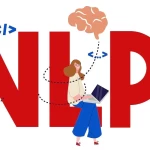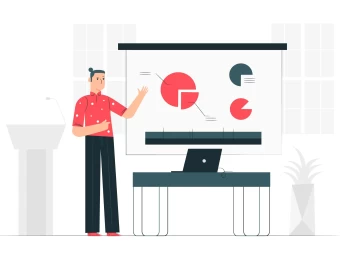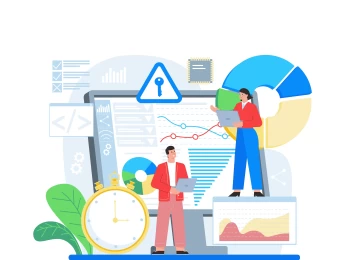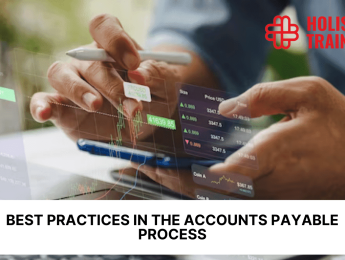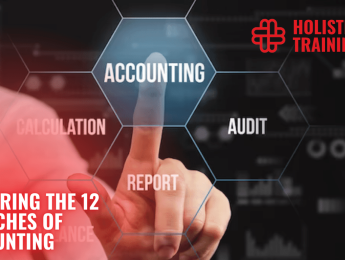- Table of Contents
- 6 Advanced Presenter Skills
- 1- Mastery of Content
- 2- Storytelling Prowess
- 3- Non-Verbal Communication
- 4- Adaptability and Audience Awareness
- 5- Visual Aids and Technology Integration
- 6- Handling Q&A with Grace
- Elevating Your Presentation Skills
- 1. Invest in Knowledge Acquisition
- 2. Craft Compelling Stories
- 3. Harness the Power of Rehearsal
- 4. Embrace Feedback Positively
- 5. Connect with Your Audience
- 6. Integrate Technology Judiciously
- 7. Practice Poise Under Pressure
- 8. Engage in Continuous Learning
- Advantages of Cultivating Advanced Presentation Skills
- Professional Credibility and Authority
- Career Advancement
- Enhanced Teaching and Training Effectiveness
- Influence and Persuasion
- Effective Team Collaboration
- Increased Engagement in Public and Social Settings
- Confidence in Public Speaking
- Increased Memorability of Your Message
- Versatility Across Communication Platforms
- The Evolution of Presentation Technology
- Transition from Transparencies to Digital Slides
- PowerPoint Revolution
- Integration of Cloud-Based Platforms
- Interactive Displays and Virtual Reality
- AI-Driven Tools and Automation
- Remote Presentations and Video Conferencing
- Caution: Balancing Technology with Message
- The Future: Integration of AI and Augmented Reality (AR)
- Conclusion
From the halls of academia to the bustling boardrooms of multinational corporations, the art of presentation stands as a testament to effective communication. A presenter, much like a skilled artist, crafts a narrative that captivates, educates, and persuades the audience. In this age of information overload, being a competent presenter is no longer sufficient – to truly stand out and leave a lasting impact, one must cultivate advanced presentation skills. In this blog post, we delve into the intricacies of these skills, unveiling the techniques used by seasoned professionals and offering insights into how you can elevate your presentation game.
6 Advanced Presenter Skills
Presenter skills encompass a spectrum of abilities that allow individuals to convey ideas, information, or proposals with clarity, confidence, and charisma. It’s not just about delivering facts; it’s about connecting emotionally with the audience, creating an engaging narrative, and driving the desired outcome. Let’s explore six advanced presentation skills that seasoned presenters have mastered.
1- Mastery of Content
The foundation of an exceptional presentation rests on a profound understanding of the content. It's not merely about skimming the surface but delving into the depths of the subject matter. Seasoned presenters go beyond memorisation; they internalise the information, allowing them to navigate the complexities with ease. This mastery empowers them to handle unexpected questions and challenges, exuding an aura of confidence and authority that resonates with the audience.
2- Storytelling Prowess
Storytelling is an art that transforms mundane data into a captivating narrative. Advanced presenters are adept at crafting stories that resonate on a personal level. They skillfully intertwine relatable anecdotes, powerful metaphors, and real-life examples, creating an emotional connection that keeps the audience engaged from the beginning to the end. This storytelling prowess not only enhances information retention but also makes the presentation memorable and impactful.
3- Non-Verbal Communication
While words convey the message, non-verbal communication adds layers of meaning. In fact,statistics show that verbal communication constitutes just 7% of the overall message, while tone of voice contributes to 38%, and body language plays a significant role, accounting for 55%. Seasoned presenters understand the silent language of confidence. From maintaining unwavering eye contact that exudes assurance to using purposeful gestures that emphasise key points, non-verbal cues are integral. Mastering body language enables presenters to convey enthusiasm, conviction, and authenticity, establishing a deeper connection with the audience beyond the spoken words.
4- Adaptability and Audience Awareness
Exceptional presenters possess a keen sense of adaptability and audience awareness. They read the room, gauging audience reactions and adjusting their approach on the fly. This dynamic awareness allows them to tailor their pacing, tone, and content delivery to maintain engagement. Navigating the dynamic terrain of diverse audience responses requires not just preparation but also the flexibility to seamlessly switch strategies, ensuring a meaningful connection with every listener.
5- Visual Aids and Technology Integration
According toDuarte, utilising visual aids in presentations increases their persuasive power by 43% compared to presentations without visual support. However, it is important to note that their misuse can be detrimental. Advanced presenters strike a balance between using slides, videos, and other multimedia elements to complement their content, not overshadow it. They leverage technology seamlessly, enhancing the presentation without turning it into a tech showcase.
6- Handling Q&A with Grace
The Q&A session is the crucible where expertise faces scrutiny. Advanced presenters anticipate potential questions, preparing thoughtful responses that showcase their deep understanding. However, the art lies not just in having answers but in handling queries gracefully. Seasoned presenters acknowledge when they don't have an immediate answer, demonstrating humility and commitment to follow up. This practice builds trust and credibility, turning the Q&A session into an opportunity to further establish the presenter's authority.
Aspiring presenters should not view these skills as isolated attributes but as interconnected elements that, when mastered collectively, elevate the art of presentation to new heights. Embrace the challenge, invest in deliberate practice, and watch as your presentation prowess evolves, making you a truly exceptional presenter capable of leaving an indelible mark on every audience you address.
Elevating Your Presentation Skills
While these skills may seem like attributes only the naturally gifted possess, the truth is that presentation skills can be developed through conscious effort and practice. Here’s a roadmap to help you embark on this journey of self-improvement.
1. Invest in Knowledge Acquisition
The journey towards mastering presentation skills begins with building a robust foundation of knowledge. Thorough research and in-depth understanding of your subject matter are imperative. Dive deep into various angles and perspectives, not only to fortify your confidence but also to equip yourself to handle any question that may arise. Invest time in becoming an authoritative figure in your field, ensuring that your presentation is built on a solid foundation of expertise.
2. Craft Compelling Stories
Storytelling isn't reserved for novels and movies – it's an integral part of effective presentations.Research indicates that when information is presented in a narrative format, individuals are 22 times more likely to retain and recall those facts. So, practice weaving anecdotes that relate to your topic. Develop a knack for identifying emotional hooks that will resonate with your audience, making your message memorable.
3. Harness the Power of Rehearsal
The adage "practice makes perfect" holds true in the realm of presentations. Rehearse your presentation multiple times, focusing not only on the content but also on your delivery, timing, and transitions. Recording yourself or practising in front of a mirror allows you to observe and refine your non-verbal cues. Through dedicated rehearsal, you not only internalise your content but also build confidence in your ability to deliver it effectively.
4. Embrace Feedback Positively
Feedback is a valuable tool on the path to improvement. Seek input from mentors, colleagues, or even anonymous evaluations. Embrace constructive criticism as an ally in refining your content, delivery, and overall presentation approach. Use the feedback received to identify areas of improvement and make necessary adjustments. This iterative process of refinement contributes significantly to your growth as a presenter.
5. Connect with Your Audience
Audience engagement is the linchpin of a successful presentation. Prioritise understanding your audience – their needs, expectations, and potential pain points. Tailor your content to address these aspects, making your presentation not only relevant but also relatable. Establish a connection by addressing your audience's concerns and aligning your message with their interests. A presenter who genuinely connects with their audience creates an impactful and memorable experience.
6. Integrate Technology Judiciously
In the digital age, technology can be a powerful ally if wielded judiciously. Visual aids should augment your presentation, not overpower it. Design slides that are clean, visually appealing, and easy to comprehend. Ensure that any multimedia elements you incorporate contribute to the narrative rather than distract from it. The integration of technology should serve to enhance the overall presentation experience, not overshadow the core message.
7. Practice Poise Under Pressure
Handling Q&A sessions is a skill that requires both knowledge and composure. Practice thinking on your feet by simulating Q&A scenarios. Develop techniques to buy time for complex questions and practise graceful ways to handle queries outside your expertise. Poise under pressure not only instils confidence in the audience but also reinforces your credibility as a knowledgeable and composed presenter.
8. Engage in Continuous Learning
The journey towards becoming an exceptional presenter is ongoing. Attend workshops, watch talks by renowned speakers, and read books on public speaking and communication. Every nugget of knowledge acquired contributes to your growth. Embrace a mindset of continuous learning, staying attuned to evolving trends and techniques in the realm of presentations. This commitment to learning ensures that your skills remain sharp and relevant in an ever-changing landscape.
In summary, the strategic roadmap to elevating your presentation skills is a comprehensive and iterative process. It involves a holistic approach that encompasses knowledge acquisition, storytelling finesse, diligent rehearsal, feedback incorporation, audience connection, technology integration, poise under pressure, and continuous learning. By embracing each step of this roadmap, you undergo a transformative journey that culminates in the evolution from a proficient presenter to an exceptional one. As you invest in this strategic approach, you become a presenter capable of leaving an indelible mark on every audience you address.
Table 1: Methods to measure the effectiveness of your presentation
Measurement Method | Description |
Audience Surveys | Collect feedback on content, delivery, and impact. |
Post-Presentation Assessments | Evaluate comprehension through quizzes or evaluations. |
Social Media Engagement | Monitor online reactions and audience interactions. |
Attendance and Participation | Gauge interest and engagement levels during the presentation. |
Follow-up Actions and Responses | Track audience actions or responses post-presentation. |
Advantages of Cultivating Advanced Presentation Skills
Cultivating advanced presentation skills isn't just a quest for eloquence; it's a strategic investment with multifaceted advantages that extend across personal, professional, and academic realms. Let's explore the compelling benefits that await those who commit to honing their presentation prowess:
Professional Credibility and Authority
Mastering advanced presentation skills elevates your professional image. The ability to convey information with confidence and clarity enhances your credibility, positioning you as an authority in your field. Whether in boardrooms, conferences, or client meetings, a polished presenter commands attention and instils trust.
Career Advancement
Exceptional presentation skills are a cornerstone of career advancement. The capacity to articulate ideas persuasively, adapt to diverse audiences, and handle challenging Q&A sessions sets you apart as a valuable asset within your organisation. Effective communication is often a key criterion for leadership roles and promotions.
Enhanced Teaching and Training Effectiveness
For educators and trainers, advanced presentation skills are indispensable. The ability to captivate and engage an audience facilitates more effective knowledge transfer. By employing storytelling, integrating technology judiciously, and mastering non-verbal communication, educators create an environment conducive to learning and retention.
Influence and Persuasion
Persuasion is a powerful skill in any field, and advanced presentation skills are instrumental in wielding influence. Crafting compelling narratives, using visual aids strategically, and adapting your communication style to resonate with your audience enhances your ability to persuade and mobilise support for your ideas, projects, or initiatives.
Effective Team Collaboration
Communication lies at the heart of successful collaboration. Advanced presentation skills empower you to convey complex ideas, facilitate discussions, and inspire your team. The ability to adapt to diverse communication styles ensures that your message resonates with each team member, fostering a culture of effective teamwork.
Increased Engagement in Public and Social Settings
Beyond the professional realm, advanced presentation skills enhance your ability to engage and connect with people in various social settings. Whether delivering a toast at a wedding, participating in community events, or presenting at public forums, these skills equip you to communicate with impact, leaving a lasting impression.
Confidence in Public Speaking
Overcoming the fear of public speaking is a common challenge. Advanced presentation skills not only mitigate this fear but instil confidence. The more you refine your skills, the more assured you become in your ability to articulate ideas, respond to questions, and navigate diverse speaking engagements.
Increased Memorability of Your Message
Exceptional presenters are not easily forgotten. The art of storytelling, impactful visuals, and a dynamic delivery style contribute to increased memorability. Your audience is more likely to retain and recall key information, ensuring that your message leaves a lasting imprint.
Versatility Across Communication Platforms
In the digital age, communication extends beyond traditional presentations. Cultivating advanced presentation skills equips you with the versatility to excel in webinars, video conferences, and other virtual communication platforms. This adaptability is increasingly valuable in a world where remote and online communication are integral parts of professional life.
In short, the advantages of cultivating advanced presentation skills are far-reaching and impactful. Whether you're seeking professional growth, aiming to excel in academia, or simply looking to enhance your social interactions, the benefits of effective communication resonate across various facets of life. By investing in the development of these skills, you unlock a host of opportunities that propel you towards success and distinction in your personal and professional journey.
The Evolution of Presentation Technology
The realm of presentation technology has experienced a transformative journey, reshaping the dynamics of how information is conveyed and absorbed. From humble beginnings with overhead projectors to the sophisticated tools available today, the evolution of presentation technology is a testament to the relentless march of innovation.
Transition from Transparencies to Digital Slides
In the early days, presenters relied on transparencies and slide projectors to illustrate their points. This method, while revolutionary at the time, had its limitations. It required meticulous preparation and often resulted in logistical challenges, such as the need for physical slides and projectors.
PowerPoint Revolution
The late 20th century witnessed a game-changing moment with the advent of PowerPoint. This software not only streamlined the process of creating visual aids but also introduced dynamic slideshows. Presenters could easily organise information, incorporate visuals, and transition seamlessly between slides, enhancing the overall presentation experience.
Integration of Cloud-Based Platforms
With the rise of cloud computing, presentation technology underwent another significant shift. Cloud-based platforms like Google Slides and Microsoft 365 enabled presenters to collaborate in real time, facilitating seamless editing and updates. This not only enhanced teamwork but also allowed for flexibility in accessing presentations from various devices.
Interactive Displays and Virtual Reality
The present era is marked by a surge in interactive displays and virtual reality (VR) applications. Interactive whiteboards and touch-sensitive screens enable presenters to engage with their content dynamically. On the frontier of innovation, VR presentations immerse audiences in a virtual environment, providing a unique and immersive experience.
AI-Driven Tools and Automation
Artificial intelligence (AI) has found its way into presentation technology, offering tools that enhance interactivity and user experience. AI-driven features include automated design suggestions, speech-to-text functionality, and even predictive analytics that gauge audience engagement. These tools empower presenters to focus more on content delivery while streamlining the design process.
Remote Presentations and Video Conferencing
The evolution of presentation technology has been accelerated by the increasing prevalence of remote work and virtual collaboration. Video conferencing tools like Zoom and Microsoft Teams have become integral to presentations, enabling presenters to connect with audiences worldwide, breaking down geographical barriers.
Caution: Balancing Technology with Message
While technology has revolutionised presentation methods, seasoned presenters emphasise the importance of balance. The focus should remain on the message, with technology serving as a supportive tool. Over Reliance on flashy visuals or complex tools can detract from the core content and dilute the impact of the presentation.
The Future: Integration of AI and Augmented Reality (AR)
Looking ahead, the integration of AI and augmented reality (AR) holds promise for the future of presentations. AI algorithms may assist in dynamically adapting content based on audience responses, while AR could overlay additional information in real time, creating a more immersive and tailored presentation experience.
The evolution of presentation technology is a dynamic narrative of progress, offering presenters an array of tools to engage, inform, and captivate audiences. As technology continues to advance, presenters must adapt judiciously, leveraging the latest innovations to enhance their storytelling without losing sight of the fundamental connection between presenter and audience.
Conclusion
Advanced presentation skills are the secret ingredient that sets remarkable presenters apart from the rest. By mastering content, storytelling, non-verbal communication, adaptability, technology integration, and Q&A handling, you can elevate your presentation prowess. Embrace the journey of improvement through knowledge acquisition, storytelling finesse, diligent rehearsal, feedback incorporation, audience connection, and continuous learning. As you cultivate these skills, you transform into an ambitious presenter capable of leaving a lasting impact on every audience you address.
If you're eager to accelerate your progress and receive expert guidance, make sure to check out our course, Advanced Presentation Skills. This immersive programme is designed to equip you with the tools, techniques, and confidence you need to captivate any audience and leave a lasting impact. Elevate your presentation skills today and embark on a path to becoming a truly exceptional presenter.




